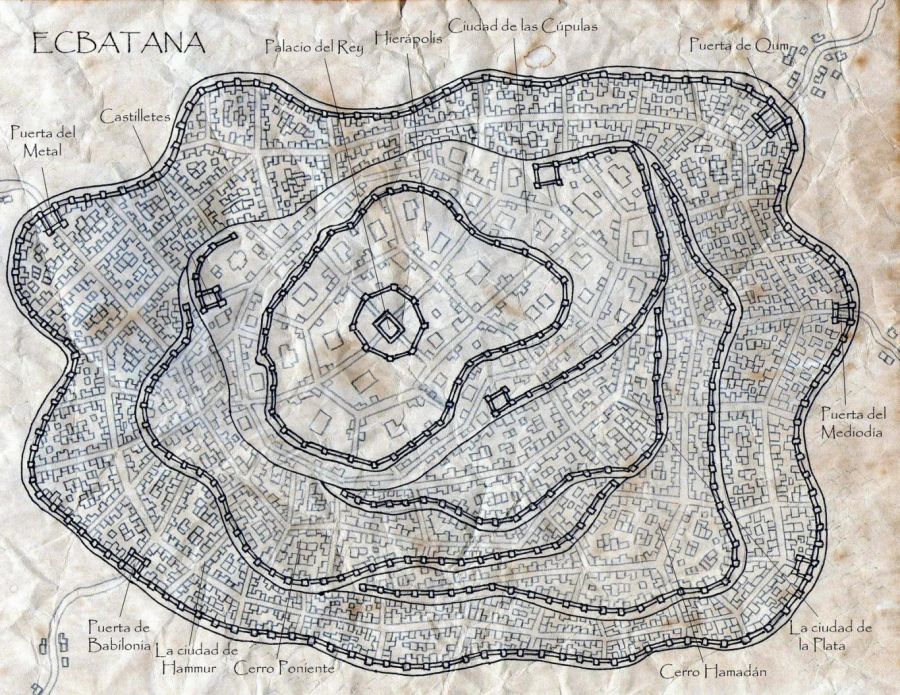
Ecbatana
Construction of Ecbatana
Ecbatana during the Achaemenids’ reign
The importance of the city of Ecbatana
The ancient city of Ecbatana is situated at the foot of the southern slopes of the Zagros mountain range. Today, Ecbatana, the former capital of the Median Empire, serves as the centre of Hamadan Province, located 230 km southwest of Tehran. It takes approximately four hours to reach Hamadan from the Iranian capital via expressway or train.
How Ecbatana was built
The earliest recorded mention of the city appears in the Babylonian chronicles of King Nabonidus in the 6th century BCE; however, the historical name ‘Ecbatana’ is found only in the works of the renowned Greek historian Herodotus in the 5th century BCE. Herodotus describes the city's palace as being encircled by seven layers of fortress walls, with gilded and silvered entrance gates and splendid chambers supported by solid cedar columns. The city is closely associated with the most successful ruler of the Medes, Cyaxares, who established Ecbatana as his capital, united the Iranian tribes, and was the first to lead victorious campaigns against Assyria and Urartu. Interestingly, the modern name of both the region and the city, ‘Hamadan’, is thought to derive either from the Median term ‘Hangmatana’ ("place of assembly") or the Elamite term ‘Halmatana’ ("land of the Medes").

Ecbatana during the Achaemenids’ reign
After the conquest of the Median kingdom, Ecbatana came under the control of the great Achaemenid dynasty (c. 700–330 BCE). Among the remnants of its former grandeur, on the outskirts of Hamadan, stands a stone inscription commissioned by Darius I and his son Xerxes, carved in three languages — Ancient Persian, New Babylonian, and New Elamite. This inscription recounts the history and achievements of these rulers. Over time, it became popularly known as ‘Ganjnameh’, and was later deciphered by French archaeologists. The text extols the greatness of the Zoroastrian god Ahura Mazda and proclaims Darius of the Achaemenid dynasty as the ‘King of Kings’. From the reign of Cyrus the Great to Darius III, the Achaemenid rulers upheld a policy of religious tolerance and cultural diversity.
During the reign of Darius, the reconstruction of the Jerusalem temple was brought to completion. According to the biblical Book of Ezra, it was in Ecbatana that the king discovered the renowned decree of his predecessor, Cyrus, which granted the Jewish people permission to return to Jerusalem and commence the rebuilding of their sacred site. Darius, in turn, provided them with financial support and protection, earning the profound gratitude of the Jewish people.
During the reign of King Artaxerxes I, grandson of Darius I, the events described in the biblical Book of Esther are said to have taken place. The king’s wife, the beautiful Esther, used her wisdom to save the Jewish people from false accusations and destruction—a heroic act that is commemorated annually during the festival of Purim. Her tomb, where her guardian Mordecai is also believed to be buried, is located in the city of Ecbatana and remains an important site of pilgrimage. However, some historians question its authenticity, suggesting instead that the tomb may belong to the Jewish wife of a Sassanian ruler.
The importance of the city of Ecbatana
After the decline of the Achaemenid dynasty in the fourth century BCE, Ecbatana became the summer capital, first of the Parthian Empire and later of the Sassanian state. Excavations on the Oil and Segment hills have uncovered ancient remains of structures dating back to the Median kingdom, the era of Darius I, and a Parthian fortress, serving as enduring reminders of the city's illustrious past. Within Ecbatana itself, an ancient lion statue has been preserved, though its origins remain uncertain. Some believe it was once part of a paired "Lion Gate" at a Parthian cemetery, while others claim it stood at the funeral of Hephaestion, the close companion of Alexander the Great, who died in the city in 324 BCE. Though mutilated in the 10th century, the statue still bears testimony to the artistry of ancient sculptors, who masterfully captured the spirit of the wild beast.
Following the Arab conquest of Iran in the mid-7th century, Hamadan remained the cultural and economic hub of the region under the rule of the Dulafids. During the reign of the Great Seljuks in the 12th century, the ancient city of Ecbatana once again became the capital, overtaking Baghdad, though it was only the subsequent Mongol invasion that brought devastation and obscurity to the city. It was in Ecbatana that the renowned medieval scholar, scientist, mathematician, and physician Ibn Sina (980–1037), known in Europe as Avicenna for his medical encyclopedia, lived and passed away. His tomb, constructed in the 1950s and designed by the Persian architect Khushang Seyhun, stands out due to its distinctive design: twelve towering columns, crowned with a conical dome, symbolise the twelve scientific disciplines to which the scholar made enduring contributions. The refined, soaring structure of the mausoleum, in accordance with the architect’s vision, is reminiscent of the early 11th-century Seljuk tomb, Gonbad-e Qabus. Surrounding the mausoleum is a park, and the complex also includes a small museum and a library.
Visitor Information
- Opening Hours:
- Monday: 09:00 – 17:00
- Tuesday: 09:00 – 17:00
- Wednesday: 09:00 – 17:00
- Thursday: 09:00 – 17:00
- Friday: 09:00 – 17:00
- Saturday: 09:00 – 17:00
- Sunday: 09:00 – 17:00
- Entrance: Paid
- Cash/Credit Card accepted: Cash
- Region: Hamadan Province
- City: Hamadan
- Address: Alvand Street, Ekbatan Square, Hegmataneh Hill
- Postal code: 6516653594
- Phone number: +988132524005
- Is open to public visitors: Yes







